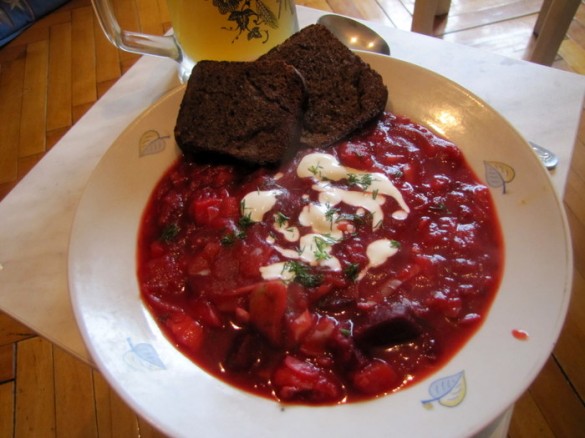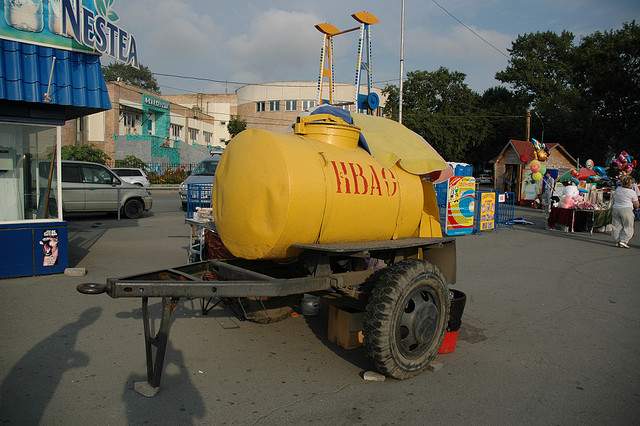I moved to Russia with a sparse knowledge of its cuisine, more or less assuming things were rich with beets and heavy with sour cream, snuggled next to wedges of rye bread. As a vegetarian, I wasn’t turned on by the salted fish or caviar; however, someone had told me that Russia is amongst the top consumers of ice cream, a fact nugget which did spark my curiosity. And, like any thin-blooded drinker, vodka was on my mind. Beyond that, beyond borsch, I didn’t know much—just some cold-hearted culinary stereotyping.
Of course, like every country, the Federation has adopted a plethora of fast food eateries. Burgers, hot dogs, and pizza have taken over a large portion of the everyday snack scene. There are yellow arches, foot-long (30 cm) subs, huts, and the standard issue European kebab stands. Also, I learned that sushi is wildly popular, as is Starbucks. I was never worried about finding something to eat, but, barring the odd night out for pizza and ice cream, I just wasn’t sure what it would be.
What I discovered—as also is the case with most countries—was that Russia has its specialties, even for the veggies of the world. There were certain foods, and not just borsch or caviar, which could not be overlooked if you were after experiencing the country authentically or at least, as I wanted to: home. Moreover, vodka was just the beginning when it came to whistle-wetting. Unusual drinks, hot and cold, alcohol or no, abound. Inevitably, flavors melded and cured into my system, became familiar and defining, and ultimately, a list of must-tastes formed:
Six Other Russian Foods You Have to Try

One thing that I recommend to any traveler in any place is to visit the local food markets, or the delicatessen sections of supermarkets, if you want to get beyond stereotypical dishes and down to real provisions. Markets tend to offer a smorgasbord of mysterious consumables, some tempting, some revolting, but what is definite is that people buy them regularly, enough to warrant a merchant going to the trouble of stocking them. Moscow has great markets, endless 24-hour grocery stores, and some damned good selections.
Pickled Stuff: I like pickles as much as the next guy. I’ve been known to grab the occasional gas station dill-in-a-bag for a treat. However, while shopping in Moscow, my enthusiasm for pickles grew to the extent of having a regular pickle lady, spending about fifty bucks (1500 rubles—over 10% of my grocery bill) on assorted pickled products each month. I sampled more than ten varieties of pickled cabbage, and lunch daily included a side of peppers and another of gherkins. Also, a little pickled accompaniment, I learned, is the proper way to enjoy that vodka.
Pancakes: Generally, Russian meals are very hearty, meat-and-potato type affairs, stew-y, soup-y, so what you don’t expect is the endless assortment of delicate crepes, known as Russian pancakes or blini. Upon first arriving, I asked my Muscovite students what food I needed to try. Blini got the biggest endorsement, and so I went the potato and mushroom route and continued sampling from there. The choices range through cheeses, vegetables, and meats, but the classic way is with sour cream, jam, and/or honey (honey comes in crazy variety).
Fried Rye/Grenki: I’m a little ashamed to say that I have, throughout my life, frequented bowling alleys (call me “the Dude”), and I’ve tried many brands of fried pickles, crinkle fries, and onion rings. Moscow turned out to be no different—a regular Tuesday session—but rather than ordering the same old snack food, a new favorite emerged: deep-fried rye bread. It comes oily, doused in garlic, and stacked log cabin-style with a mayonnaise-y sauce to dip it in. Eating it is perhaps one of the unhealthiest feelings going: The world round should have this snack.
Salads: These are not bowls of lettuce, which is in surprising shortage in Moscow (the only lettuce I got came from the supermarket in potted, live-plant form). More so, Russian salads are heavily laced in mayonnaise and are more centered on cabbage, a la coleslaw, or potato. At Christmas time, it’s salad that centers the holiday table: Olivier is started with potatoes and mayo and hosts a collection of vegetables (carrots, peas, pickles…), a choice of meats (hot dogs, salted fish, ham…), and boiled egg. Again, grocery stores have an endless choice to try.
Chocolate: I’ve never been involved with a culture so enthusiastic about its chocolates. If ice cream is the favorite treat, then dark, milk, and semi-sweet is an impossibly close second. For every occasion, boxes of chocolate are exchanged, so much so that my wife and I ate a couple of chocolates a night for months without ever buying our own. Though not all of it is Russian, it’s adopted as such and ranges from dirt cheap to unreasonably posh. Russian supermarkets tend to dedicate a much more substantial space to chocolate than other countries I’ve visited.
Tvorog: Otherwise recognized as Russian cottage cheese, tvorog is a favorite for breakfast, lunch, and dinner. It’s wrapped in pancakes, eaten with a bit of honey, or stuffed into pastries. Locals, who hold this cheese above all others, will note that it is not the same as similar versions around the world but is, in fact, much better. I don’t know how true this is, but I must say that tvorog featured more commonly in my diet than cottage cheese ever did back home. As well, it is much drier and cheesier than the soup-y mixtures most of us are accustomed to.
Six Things to Sip Besides Vodka
Vodka is no doubt the most internationally famous Russian beverage, but the country has a strange amount of unique things to drink, both tipsiness-inducing and non-alcoholic. There are special drinks to warm up on winter days and sugary-sweet cold ones to combat the surprisingly sweltering Moscow summer. Whatever time it is, whatever your particular flavor of choice, I’d looked to Russia’s awesome public parks as the place to partake. Technically, it’s illegal to drink in public, but as you’ll learn quickly, that’s technical B.S.
Kvass: The beer before beers, kvass is a fermented rye drink with low-alcohol content and is enjoyed by both young and old. It’s served cold, especially on hot days (yes, there are hot days in Russia), and it’s sickly sweet, which is probably why it’s treated more or less as a soft drink. During the summer, little on-tap kvass stands begin to pop in the parks and near hubs of commerce. The drink can be somewhat of an acquired taste (I learn to occasionally appreciate it), but kvass is a must-try on the Russian experience list. The citizenry loves it.
Beer: Pivo (pronounced pee-va), which in stores can be cheaper than water, is imbibed at just about any time of day, in manners as casual as strolling down the sidewalk, waiting at the bus stop, or waking up. Beer in Russia is available in knock-you-down strong, up to 12 % alcohol content, and comes in bottle selections from twelve ounces to two-and-a-half liters. While ultra cheap in corner shops, in bars a half-liter can easily run as much as ten dollars, so on a budget, it’s probably best to hunker down on the stoops for afternoon refreshment with the locals.
Medovukha: Also known as mead, this drink—a condensed honey beer-like substance—becomes really popular around Christmas time, and along the lines of kvass in the summer, stalls appear in the snow-laden parks, where you can buy hot mead for your frosty stroll. Outside of Red Square, or just at the edge of Revolution Square, there is a particularly great stand with a man in a wolf-pelt playing drums above the taps. Medovukha is absolutely delicious, strong, and should be drunk in small, have-a-taste doses.
Gazirovka: Walking into the GUM, as a center piece, there is this lovely soda fountain with a highly artificial array of colors and usually an anxious line of people waiting to get their “fizzy water.” An old Soviet tradition, gazirovka is more of gimmick now than a commonly enjoyed treat. However, soda fountains are set up here and there, especially in touristy spots, and the shtick is to order your carbonated water and have the soda jerk add one of those flavors floating in the glass bulbs. The fountains are beautifully enticing, so why resist them?
Kefir: If you’ve been to Turkey, then you’re more than likely familiar with a yogurt drink called ayran, and this is Russia’s version and is very unlike the deliciously fruity Dannon grab-n-gos. Kefir is basically soured milk with a sweetened twist, and when seeking to enjoy things authentically Russian, it has to be included on the list. Like the tvorog, this is something Russians swear by as a staple of good health and ranks amongst the top of the country’s many and varied dairy products..
“Champagne”: The French, of course, have taken quite the issue with the unauthorized bastardization of their oft-copied-but-never-duplicated party toaster. However, as a matter of national pride and tradition, Russian makers have refused to give up the name, so much so that court battles have ensued. Regardless, the name has remained, and Russian champagne is ubiquitously loved. As tends to be the trend with Russian beverages, this version is much sweeter than France’s (or California, etc.) and is used mostly for celebratory purposes.
Unique food and beverage always tops the list of what I want to do somewhere. I believe it’s one of the most vivid remembrances for travelers, and my home’s (Louisiana) own unique cuisine is probably the thing I most miss since going away. However, one of the things I’ve always loved about being an ex-pat somewhere is finding those other things, the lesser known culinary attractions which are part of everyday life. I especially like being able to introduce these new flavors to those family members and friends, readers, who visit and have probably never heard of them. When I leave, my stories often tend to focus on what I ate and drank.
By all means, when I lived in Russia, I had borsch. I shot vodka. That’s the stuff we know and, in this case, really culturally accurate stuff, too. Russia, not exactly a culinary marvel in the world, did not disappoint, even for a vegetarian unable to taste the luxurious caviar, the shashlik (Russia barbecue skewers), or salted fish. I missed out on various soups, most of which contain meat or meat-based broths, but I still found enough to brag about, to remember fondly. There is a Russia to taste, beyond borsch.
Find a flight to Moscow and check out the Moscow Indie Travel Guide
Jonathon Engels, a patron saint of misadventure, has been stumbling his way across cultural borders since 2005 and is currently volunteering in the mountains outside of Antigua, Guatemala. For more of his work, visit his website and blog.
Photo credits: xJason.Rogersx; all other photos courtesy of the author and may not be used without permission.

